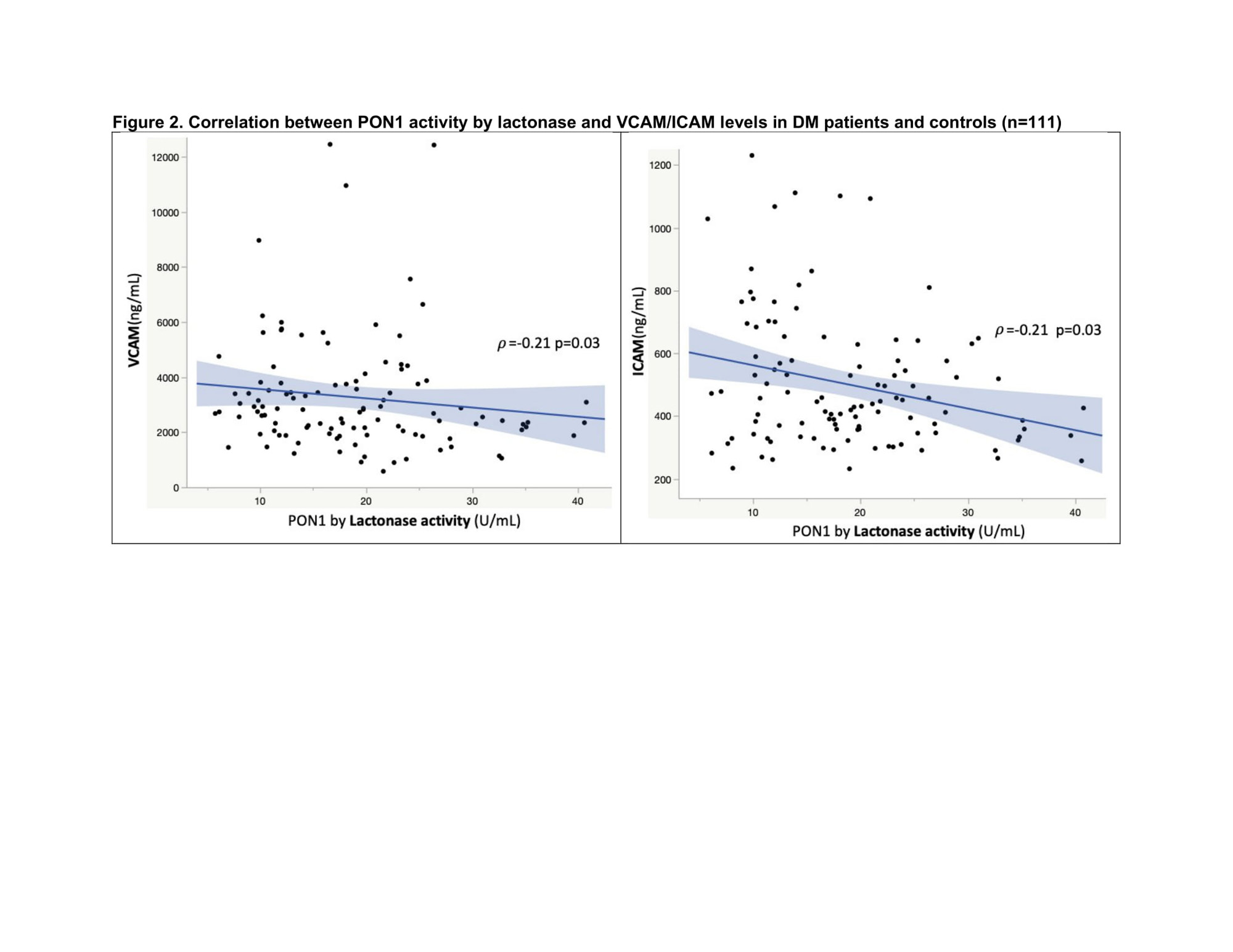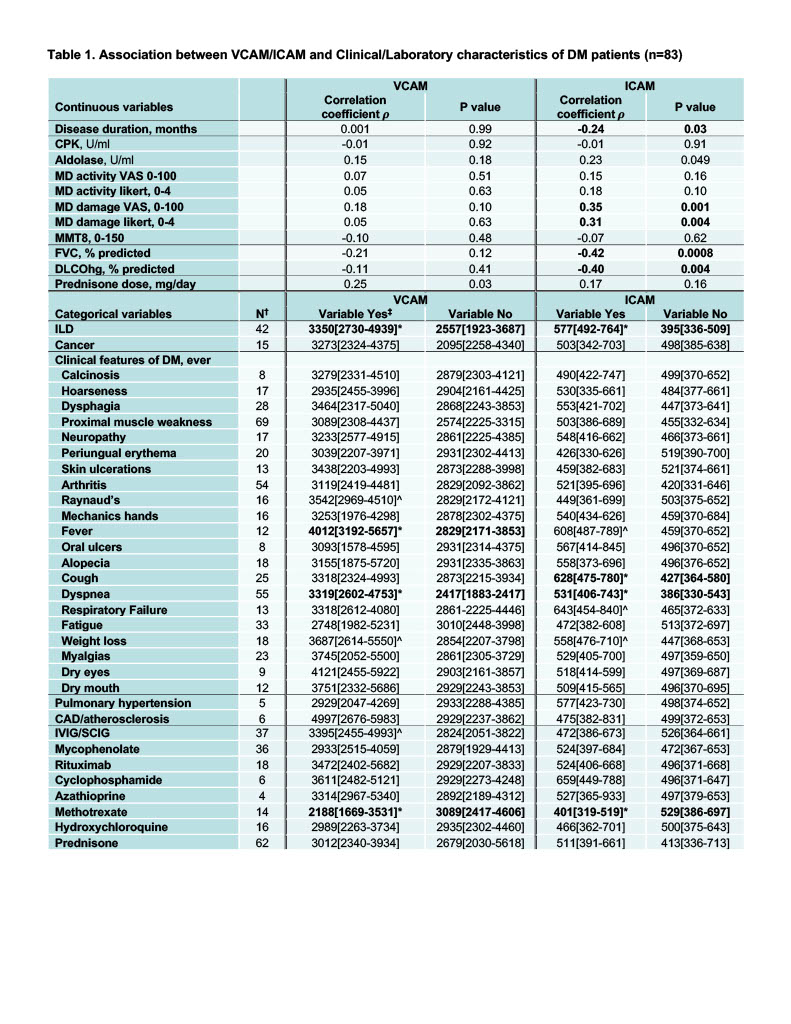Session Information
Date: Sunday, November 12, 2023
Title: (0283–0307) Muscle Biology, Myositis & Myopathies – Basic & Clinical Science Poster I
Session Type: Poster Session A
Session Time: 9:00AM-11:00AM
Background/Purpose: Damage to the vascular endothelium is implicated in the pathogenesis of idiopathic inflammatory myopathies (IIM) and its associated interstitial lung disease (ILD), with microvascular involvement most described in the dermatomyositis (DM) subtype. Paraoxonase-1 (PON1) is a high-density lipoprotein (HDL)-associated enzyme that protects the vascular endothelium from damage due to oxidized phospholipids, that is associated with IIM disease activity and presence of severe ILD. We hypothesize that poor PON1 activity is associated with vascular damage evidenced by increased circulating levels of intercellular cell adhesion molecule-1 (ICAM), vascular cell adhesion molecule-1 (VCAM) leading to higher disease burden in DM and DM-ILD.
Methods: We performed a cross-sectional study. Plasma levels of VCAM and ICAM and PON1 activity were analyzed in 83 DM patients with anti-Jo1 (n=24), MDA5 (n=29), and TIF1gamma (n=30) and 28 age and sex matched healthy controls. PON1 activity was measured using the paraoxonase, arylesterase and lactonase assays. VCAM and ICAM levels were measured by ELISA. Multivariate models were adjusted for variables that were significantly associated with the outcome variable in univariate analysis.
Results: Plasma levels of both VCAM and ICAM were significantly higher in DM patients compared to controls (Figure 1). VCAM and ICAM were particularly higher in the anti-Jo1 and MDA5 positive DM patients compared to the anti-TIF1gamma patients and healthy controls (Figure 1). VCAM and ICAM were both correlated with worse PON1 activity measured by lactonase assay (Figure 2). ICAM remained significantly associated with worse lactonase activity after multivariate adjustment for ESR, triglyceride and Asian race, which were associated with ICAM in univariate analysis. VCAM and ICAM were both significantly higher in DM patients with ILD compared to DM patients without ILD (Table 1). Higher ICAM levels also associated with worse forced vital capacity(FVC), diffusion capacity(DLCO), higher global damage scores, cough, dyspnea, while VCAM was associated with dyspnea and fever (Table 1). Patients on Methotrexate had lower ICAM and VCAM levels compared to those not on methotrexate. In a multivariate logistic model, the presence of ILD remained significantly associated with higher ICAM levels after adjusting for Methotrexate, ESR, disease duration and Asian race.
Conclusion: Plasma VCAM and ICAM were higher in DM patients compared to matched healthy controls, particularly in anti-Jo1/MDA5 ab + patients (compared to TIF1gamma ab + patients) and in DM patients with ILD. ICAM was significantly associated with worse PON1 enzyme activity, suggesting that poor anti-oxidant function of HDL associates with evidence of endothelial activation and damage in DM and DM-ILD. Large prospective studies may be warranted to further evaluate the role of PON1 in the development and propagation of IIM and IIM-ILD.
*p<0.01 by Wilcoxon test
Anti-Jo1 (N=24), anti-MDA5 (N=29), anti-TIF1 (N=30) and Age/sex matched healthy controls (N=28)
Spearman correlation coefficient (ρ) between PON1 by lactonase with VCAM and ICAM levels.
† N refers to number of patients who has ever had the listed variable as a clinical feature of their myositis
‡ Variable Yes refers to median[IQR] of VCAM/ICAM levels of those with listed variable.
To cite this abstract in AMA style:
Bae S, Shahbazian A, Wang J, De Leon T, Lee Y, Reddy s, Charles-Schoeman C. Markers of Endothelial Damage Are Elevated in Patients with Dermatomyositis Associated Interstitial Lung Disease and Associated with Low Paraoxonase-1 Activity [abstract]. Arthritis Rheumatol. 2023; 75 (suppl 9). https://acrabstracts.org/abstract/markers-of-endothelial-damage-are-elevated-in-patients-with-dermatomyositis-associated-interstitial-lung-disease-and-associated-with-low-paraoxonase-1-activity/. Accessed .« Back to ACR Convergence 2023
ACR Meeting Abstracts - https://acrabstracts.org/abstract/markers-of-endothelial-damage-are-elevated-in-patients-with-dermatomyositis-associated-interstitial-lung-disease-and-associated-with-low-paraoxonase-1-activity/



